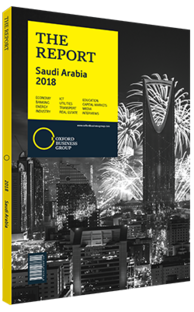Sovereign investment fund assets to double in Saudi Arabia
Unveiled in October 2017, the Public Investment Fund (PIF) Programme 2018-20 is a development roadmap that aims to position the PIF as one of the world’s top sovereign wealth funds. Key objectives of the plan are to increase assets under management from $230bn to $400bn by 2020 and $2trn by 2030, and achieve average investment returns of 4-5% by 2020, up from 3% in 2017. Yasir Al Rumayyan, managing director of the PIF, was more optimistic for the longer term, telling Bloomberg in October 2017 that the fund was looking to generate returns of 8-9% per annum by 2025. In comparison, Norway’s sovereign wealth fund – which is the largest in the world at a value of some $1trn – provides an average annual return of 4%.
Overseas Partnerships
A significant element of the plan consists of increasing the PIF’s overseas asset base. Foreign partnerships are projected to account for 25% of assets by 2020, up from 5% in late 2017. This represents a major diversification of holdings – one of the key performance indicators of the programme – and will be the principle tool for doubling the fund’s assets by the end of the decade. This process is already under way; the PIF has invested $3.5bn in ride-hailing app Uber, committed $20bn to an infrastructure fund being established by US-based equity firm Blackstone and announced it would undertake up to $10bn in investment in partnership with the Russian Direct Investment Fund.
One of the largest commitments by the PIF was made in May 2017, when the government said it would invest up to $45bn in a new technology fund being developed by the Japanese telecoms company SoftBank. The investment seeks to position Saudi Arabia at the forefront of the information revolution, as the SoftBank Vision Fund is actively targeting investments across the technology sector, including robotics and artificial intelligence. In October 2017 the PIF announced even bolder plan, with officials stating it would invest $1bn in the space tourism programme of Virgin Galactic company. In its efforts to increase offshore asset holdings, the PIF sees tie-ups with overseas partners as a driving force to attract foreign direct investment (FDI) to local endeavours, particularly where knowledge transfer is required to localise the development of new technologies. FDI for 2018-20 is forecast to reach SR20bn ($5.3bn).
Privatisation
Some of the funds required for the PIF’s investment scheme will come from Saudi Arabia’s privatisation programme. A number of industries and state activities are slated for partial or total sale, presenting opportunities for domestic and foreign investors. Key to this programme is the offering of a 5% stake of state oil giant Saudi Aramco, expected to take place in 2018. Overall, the privatisation programme aims to generate $300bn. Additional resources will be borrowed through capital markets and raised from the revenue of existing assets placed back into the fund.
Industrial Zone
One of the flagship developments backed by the PIF is the Neom project, a 26,500-sq-km industrial zone along Saudi Arabia’s Red Sea and Gulf of Aqaba coastline. The zone, financed with around $500bn from the PIF and the local and international private sector, will also include land in Jordan and Egypt. The project foresees the widespread use of automation and data exchange – including cognitive computing and the internet of things – to improve the city’s efficiency in areas such as water and utilities, biotechnology, renewable energy, food and agro-processing, and advanced technology manufacturing, as well as residential, recreational and entertainment facilities. Most importantly, Neom is intended to become a digital sciences and robotics centre. The zone will require extensive infrastructure investment, but greenfield transport and logistics work is needed before the principle undertaking can be rolled out. These projects could have a major impact on the construction sector, with the PIF estimating they will generate some 256,000 new jobs in the period to 2020.
You have reached the limit of premium articles you can view for free.
Choose from the options below to purchase print or digital editions of our Reports. You can also purchase a website subscription giving you unlimited access to all of our Reports online for 12 months.
If you have already purchased this Report or have a website subscription, please login to continue.

